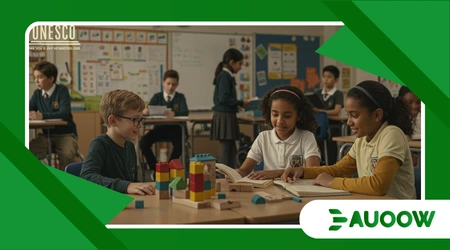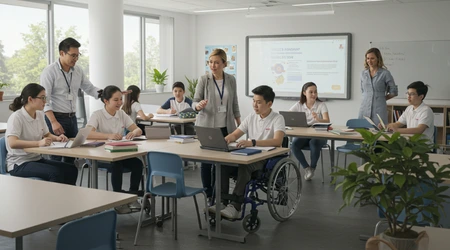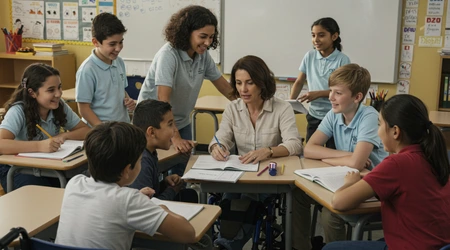UNESCO’s Roadmap for Inclusive Education: What’s New

UNESCO’s Roadmap for Inclusive Education charts a bold path to ensure no learner is left behind. In 2025, this vision gains fresh momentum, building on decades of advocacy for equitable education systems.
Rooted in the 1994 Salamanca Statement and the 2030 Agenda for Sustainable Development, UNESCO’s updated strategies tackle persistent barriers while embracing modern challenges like digital divides and climate crises.
This article dives into the roadmap’s latest updates, exploring how they reshape global education with practical, inclusive solutions. Why should we care? Because education is the cornerstone of a just society, and UNESCO’s work is a call to action for all.
The roadmap’s evolution reflects a world in flux. From addressing AI’s role in classrooms to fostering leadership for inclusion, UNESCO’s approach is both ambitious and pragmatic.
It emphasizes systemic change, urging governments, educators, and communities to rethink how education systems embrace diversity.
With 244 million children still out of school globally, the stakes are high. This piece unpacks the roadmap’s key pillars, offering insights into its innovative strategies and real-world applications. Let’s explore what’s new and why it matters for building inclusive futures.
A Legacy of Inclusion: The Foundation of UNESCO’s Vision
The UNESCO’s Roadmap for Inclusive Education builds on the transformative 1994 Salamanca Statement, which championed inclusive education for all, regardless of ability or background.
This foundational document shifted global perspectives, urging schools to adapt to diverse learners. Today, UNESCO refines this vision, addressing modern complexities like migration and technological disparities. The roadmap’s core principle remains: every learner matters equally.
Inclusion isn’t just a buzzword; it’s a moral and practical necessity. UNESCO’s framework emphasizes dismantling barriers be they social, economic, or cultural that exclude learners.
For example, in Jordan, UNESCO’s 2022 initiative with GIZ developed a capacity-building roadmap for inclusive education, aligning with national strategies. This practical approach shows how global goals translate locally.
The roadmap also integrates Sustainable Development Goal 4 (SDG 4), aiming for equitable education by 2030.
++ Inclusive Education in 2025: Global Best Practices You Should Know
It calls for policies that embrace diversity as a strength. In Armenia, an NGO-led campaign secured a national framework for inclusive education by 2025, proving grassroots efforts can drive systemic change.
Collaboration is central. UNESCO urges partnerships between governments, NGOs, and communities to ensure inclusive policies are actionable.
This multi-stakeholder approach fosters accountability and innovation, making inclusion a shared responsibility. The roadmap’s legacy is its adaptability, addressing today’s challenges while staying true to its inclusive roots.

Embracing Technology: AI and Digital Inclusion
Artificial intelligence is reshaping education, and UNESCO’s Roadmap for Inclusive Education places it front and center. AI can personalize learning, but without careful integration, it risks widening gaps.
UNESCO’s 2023 guidelines on generative AI in education emphasize ethical use to ensure inclusivity. Less than 10% of schools globally have formal AI policies, highlighting the urgency.
Consider a rural school in Bhutan, where UNESCO’s digital transformation projects provide tablets to students with limited access.
This initiative bridges connectivity gaps, enabling tailored learning for diverse needs. Technology, when inclusive, empowers rather than excludes, aligning with UNESCO’s vision of equitable education.
Yet, challenges persist. The roadmap stresses training teachers to use AI effectively, as 40% of countries lack inclusive tech training.
Also read: How AI-Powered Personalized Learning is Transforming Inclusive Education
UNESCO’s Digital Learning Week 2025 will focus on empowering educators, ensuring technology serves all learners. Digital divides must be addressed to prevent exclusion.
The roadmap also tackles accessibility. Assistive technologies, like screen readers, enable students with disabilities to engage fully.
UNESCO’s partnerships, such as with Dubai Cares, promote digital infrastructure investments, ensuring no child is left offline. This focus on tech equity is a game-changer for inclusion.
Leadership for Inclusion: Empowering Educators and Systems
Strong leadership is the backbone of inclusive education. UNESCO’s Roadmap for Inclusive Education prioritizes training school leaders to foster inclusive environments.
The 2024/5 Global Education Monitoring Report highlights leadership’s role in driving equity, with regional editions planned for 2025 to tailor solutions.
In Colombia, UNESCO’s 2019 forum inspired school principals to adopt inclusive curricula, celebrating diversity.
This example shows how leadership training translates into classroom impact. Leaders must champion policies that value every learner’s potential, from refugees to those with disabilities.
Teacher training is equally critical. UNESCO notes that 40% of countries still don’t train teachers on inclusion.
Read more: Adapting Science Labs for Physical and Cognitive Accessibility
The roadmap advocates for professional development to equip educators with strategies for diverse classrooms. Imagine a teacher as a gardener, nurturing each unique plant to thrive UNESCO’s vision mirrors this analogy.
Systemic leadership also matters. The 2024 Fortaleza Declaration, adopted by 50+ ministers, emphasizes sustainable financing for inclusion.
Governments must prioritize budgets that support inclusive infrastructure, ensuring schools are accessible to all. Leadership at every level drives the roadmap’s success.
Addressing Global Challenges: Climate, Migration, and Equity
The UNESCO’s Roadmap for Inclusive Education confronts emerging global challenges like climate change and migration.
Climate disruptions displace millions, affecting education access. UNESCO’s Education for Sustainable Development (ESD) for 2030 framework integrates climate education, preparing learners to tackle environmental crises.
Migration poses another hurdle. Over 7 million refugee children are out of school. UNESCO’s roadmap pushes for inclusive policies that integrate displaced learners.
In Lebanon, the NGO Sonbola provides quality education for Syrian refugees, aligning with UNESCO’s call for sustainable solutions. This ensures education isn’t a casualty of crisis.
Equity remains a cornerstone. The roadmap addresses intersecting disadvantages gender, poverty, disability that exclude learners.
UNESCO’s 2020 GEM Report notes that 60% of children globally struggle with basic literacy, often due to systemic inequities. Targeted policies, like Ghana’s Inclusive Education Policy, show progress by mobilizing NGOs for support.
The roadmap also emphasizes data collection to identify excluded groups. Without data, solutions are guesswork.
UNESCO’s 2024 Conference on Education Data pushed for evidence-based policies, ensuring no learner is invisible. This holistic approach makes the roadmap a vital tool for equity.
Community and Civil Society: A Collaborative Push

Inclusion thrives on collaboration, and UNESCO’s Roadmap for Inclusive Education champions civil society’s role.
NGOs, parents, and communities are vital in holding systems accountable. In Ghana, NGOs monitor inclusive education policies, ensuring resources reach marginalized groups. This grassroots advocacy is a roadmap priority.
Civil society bridges gaps governments can’t. For instance, Inclusion International’s 2024 paper for the GEM Report emphasizes community-driven leadership for inclusion. Local voices ensure policies reflect real needs, making inclusion practical and sustainable.
UNESCO also fosters global networks. The Global Network of Learning Cities promotes lifelong learning for diverse groups, like refugees.
These networks share best practices, amplifying impact. Communities aren’t just beneficiaries they’re active partners in shaping inclusive education systems.
Partnerships extend to international organizations. UNESCO’s collaboration with UNICEF and the World Bank supports digital learning for marginalized groups, as seen in Bhutan’s digital transformation efforts. This collective approach ensures the roadmap’s goals are actionable and far-reaching.
Measuring Progress: Data and Accountability
Tracking progress is critical for inclusion, and UNESCO’s roadmap emphasizes robust data systems. The 2024 Global Education Meeting introduced SDG 4 benchmarks, with 79% of countries submitting targets for 2025 and 2030. Data drives accountability, ensuring commitments are met.
| Indicator | Target by 2025 | Progress (2024) |
|---|---|---|
| Out-of-school children | Reduce to 10% | 244 million remain |
| Teacher training on inclusion | 60% of countries | 40% lack training |
| Digital access for students | 80% connectivity | 1.3 billion without |
This table highlights gaps and goals. UNESCO’s Dashboard of Country Commitments tracks progress, ensuring transparency. Data reveals where interventions are needed, like addressing the 1.3 billion children without digital access.
Accountability extends to policy. The roadmap urges governments to enact inclusive laws, as seen in Jordan’s 10-Year Strategy for Inclusive Education.
Regular monitoring ensures policies evolve with needs. UNESCO’s tools, like the Profiles Enhancing Education Reviews (PEER), guide countries toward inclusive reforms.
Engaging communities in data collection is key. UNESCO’s partnerships with NGOs ensure marginalized voices shape metrics.
For example, the Worldwide Inequality Database on Education (WIDE) exposes disparities, driving targeted action. Accountability is the roadmap’s engine for change.
Looking Ahead: The Future of Inclusive Education
The future of inclusive education hinges on bold action, and UNESCO’s roadmap sets a clear course. By 2030, SDG 4 aims for universal quality education.
The roadmap’s focus on AI, leadership, and equity ensures systems evolve with global challenges. But can we afford to wait?
Emerging technologies offer promise but demand caution. UNESCO’s 2025 focus on AI and human agency, celebrated on International Education Day, will guide ethical tech integration. Schools must balance innovation with accessibility to avoid new forms of exclusion.
Global crises like climate change and migration will test the roadmap’s resilience. UNESCO’s ESD framework and refugee education initiatives provide practical tools.
For example, integrating climate literacy in curricula empowers students to address environmental challenges, fostering inclusive, sustainable societies.
Collaboration remains the linchpin. The roadmap’s success depends on governments, NGOs, and communities working together.
The 2024 Fortaleza Declaration’s call for sustainable financing underscores this, urging innovative funding like debt swaps. Inclusion is a collective journey.
Ultimately, UNESCO’s Roadmap for Inclusive Education is a blueprint for a world where every learner thrives. It’s not just about access it’s about belonging.
By embracing diversity, leveraging technology, and fostering leadership, UNESCO paves the way for equitable education. The roadmap isn’t a finish line; it’s a starting point for a more inclusive future.
Frequently Asked Questions
What is UNESCO’s Roadmap for Inclusive Education?
It’s a strategic framework to ensure equitable, quality education for all, addressing barriers like disability, poverty, and digital divides, updated for 2025 challenges.
How does the roadmap address technology in education?
It promotes ethical AI use and digital access, with initiatives like Bhutan’s tablet programs, ensuring technology supports inclusion without widening gaps.
Why is leadership important in the roadmap?
Leadership drives systemic change. Training educators and policymakers, as in Colombia’s inclusive curricula, ensures schools embrace diversity effectively.
How can communities contribute to the roadmap?
Communities, including NGOs, monitor policies and advocate for marginalized groups, as seen in Ghana’s inclusive education efforts, ensuring grassroots impact.
